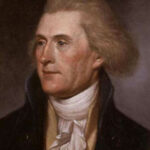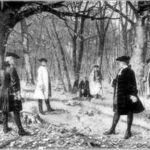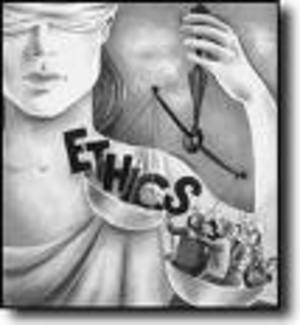A Fatal Friendship: Alexander Hamilton and Aaron Burr is a fascinating biography about the first time a sitting Vice President shot another man. As comedian Jon Stewart observed, Dick Cheney shot his “friend” because he mistook him for a bird. The reasons why Aaron Burr-Thomas Jefferson’s Vice President-shot Alexander Hamilton are shrouded in mystery, though we can be absolutely certain of one thing: Burr didn’t mistake Hamilton for a quail.
The opening section of the biography delves deeply into Alexander Hamilton’s-America’s first Secretary of the Treasury-illegitimacy. Pulling absolutely no punches, the author Arnold Rogow describes Hamilton’s mother as a slut at and there is quite a bit of confusion and controversy over who his father actually may have been. Rogow briefly tantalizes the reader with speculation-quickly disregarded-that George Washington himself was the sire of his future aide-de-camp. There is even some dissatisfaction among biographers over when Hamilton was born, much less who fathered him. The book considers statements made by Hamilton himself as well as others in estimating his birthdate to be somewhere around 1755 to 1757.
In stark contrast to the confusions surrounding Hamilton’s birth are the events surrounding Burr’s birth. It is well known when he was born and who was his father. Both Burr’s father and mother succumbed to illnesses when Burr and his sister were quite young. Still, he grew up among quite affluent conditions, at least compared to the low station of Hamilton’s youth. There would be many parallels and many contrasts between the two men, this being just the earliest of the latter.
Where they might have had the same outlook, strangely enough, was during the war in regard to G. Washington. Though Washington adored Hamilton and kept him by his side for almost the rest of his life, it appears that Hamilton’s opinion of the General and subsequent father of his country was a bit less noble. Though, or perhaps because of, serving in such close proximity, Hamilton often spoke ill behind the General’s back and questioned his ability as a field general. Nobody is sure exactly why Burr disliked Washington so much, but he made no attempt to hide it and it is clear that Washington held Burr in equal contempt. It is certain that the two men did not care for each other.
There is another aspect of life that Burr and Hamilton shared. They both had quite the roving eye for the ladies ladies. Though both were married, Burr and Hamilton each engaged in multiple affairs of the heart; sometimes with the same woman! It is even suggested that Hamilton had an affair with his own sister-in-law while quite a bit of the book relates to the exceptionally close relationship that Burr had with his daughter. This relationship was and is in the book compared more than once to a marriage more than a parent/offspring relationnship. Whether there actually was any incestuous behavior is left up to the reader to decide, though the subject arises yet again later in the story of the duel.
As might be expected the book goes into some detail about the so-called Reynolds Affair, in which Hamilton may have been uncharacteristically duped by one of his sexual conquests into taking part in an extortion plan. In an example of how different times have become for politicians, the husband of the woman involved had no compunction whatever about his wife sleeping with Hamilton, he just wanted Hamilton to pay for the privilege. Despite paying Reynolds off, his marital infidelity became public knowledge and ever after tainted his reputation. His penchant for adultery may even have played a part in bringing about the infamous duel itself. On the other side of the coin, Burr’s fondness for feminine company even included, it is suspected, Dolley Todd, who was later to become much more famous as Dolley Madison. (Pres. James Madison’s wife, not the maker of delicious snack treats).
Yet another similarity between the two men is what each did after the revolutionary war came to an end. They both settled in New York and practiced law while looking toward politics. While doing so both went into debt even though Hamilton engaged in what today would be called insider trading in order to help his creditors out. Burr managed to sink into debt despite charing legal fees that many considered exorbitant.
According to this book, though Hamilton did indeed contribute mightily toward writing The Federalist Papers, his part in the creation of the US Constitution was actually smaller than is usually thought. In fact, according to this book Hamilton thought the Constitution was a failure compared to what he’d wanted. Even so, because he had such a poor opinion of the alternative, the Articles of Confederation, he worked hard to get the Constitution ratified. His speech at the Constitutional Convention may well be where his reputation as a monarchist began. Burr likewise hated the Constitution and predicted it would not last fifty years. (He was wrong, of course. The Constitution lasted as the law of the land for 211 years).
Hamilton enjoyed intriguing behind the scenes more than doing so openly. He did so in the election of 1796, though not against Burr, but against John Adams. By by doing so, he ensured that Burr-a longshot at best-would remain so. Hamilton so irritated the Adams family by his designs to assure the Presidency for Thomas Pinkney that John referred to him as a hypocrite and Abigail Adams said that the devil hid behind his eyes.
That may well have been the case. Or if not the devil, Hamilton certainly had other darker intentions behind his eyes. He in fact was running a shadow government not far from the oblivious eyes of the Chief Executive. The Secretaries of State, War and Treasury under John Adams were all close friends of Hamilton and through them he was able to establish policy without Adams expecting anything until he became aware that Hamilton was again plotting against his re-election to the Presidency. While Aaron Burr was thought by many to merely be a man operating completely without a moral compass, Alexander Hamilton is now thought to have possibly been suffering from some sort of mental instability, perhaps manic depression or bipolar disorder as it is now called. It is the only logical reason that many biographers can come up with to account for his Letter against the Re-election of John Adams. It was a letter dripping with venom and which ultimately turned out to be one of the most self-destructive acts ever undertaken by an American politician.
Perhaps it was the paranoid tendencies of someone suffering from a mental illness that led Hamilton to engage in a violent series of letters urging the Federalists not to swing to Aaron Burr in the controversial election of 1800 when Burr and Thomas Jefferson were tied in the electoral college and the election was flung into the hands of the House of Representatives.
Despite the many similarities and dissimilarities between the two men, the book offers no simple explanation for what led to the duel. Hamilton in particular seems to have held a dislike for Burr which certainly verges on the obsessive. He opposed Burr’s election to the Presidency as well as to the Governorship of New York. Still, the turning point in their strained relationship seems to revolve around the fact that Hamilton is alleged to have to said that Burr was “still more despicable” than he’d previous called him. What this extra layer of despicability was has never been proven, though theories abound, including the possibility that Hamilton was implying there was an incestuous relationship between Burr and his daughter.
In the weeks leading up to the infamous duel, however, there were a series of letters passed back and forth between the two men. At one point Burr asked him to disavow the statement of Burr being “still more despicable,” but Hamilton refused, using technical legal jargon as a way of getting out of the disavowal. As the book states, the incidents which transpired during and immediately after the duel are unclear even to this day due to erratic accounts by witnesses.
The “seconds” to the duel both agreed that shots were fired from each participant. However, they disagreed on the sequence and timing of the shots. They also disagreed on a good many other events concerning the duel. For instance, it remains questionable whether Hamilton even fired at Aaron Burr at all, or was it just a matter of his gun accidentally going off. In fact, the reports of the two seconds make it appear as though they both witnessed two completely separate sets of events leading up to the killing of Alexander Hamilton. We will never know what “caused” this duel to come to being nor will we ever be completely certain which way truth lies in regard to the events of the duel itself. This will remain one of the great mysteries of American history.



